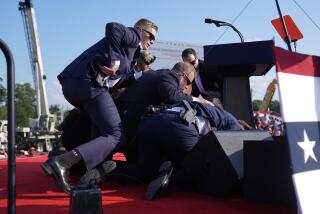Step One: Station a Marshal Outside Every Cockpit Door
- Share via
Two days before the disaster, I was planning to fly over the World Trade Center myself.
Last Sunday afternoon, I was piloting a little propeller plane from a small airport outside Boston to another outside Washington. My wife and I had just delivered a son to college. It was a memorably clear and beautiful late summer day. The skyline of Manhattan, 20 miles to our side, was so sharp and vivid that we talked about swinging off course to cross over the city and then look down on Arthur Ashe Stadium as Pete Sampras and Lleyton Hewitt slugged it out below. As long as we climbed above the 7,000-foot ceiling of the controlled airspace around New York’s major airports, we could look to our hearts’ content. But we were eager to get home, and we planned to come that way again soon.
“Next time,” I said to my wife, as we headed straight to Washington.
There may not be a next time, as everything involving air travel becomes more constrained. The tightening of security, while necessary, almost certainly will have aspects of fighting the last war. We may spend years refining passenger-screening processes, only to have the next terrorist explosive arrive by barge. But as we undertake this process, it is worth recognizing how fundamentally vulnerable our air system is likely to remain if it is to function at all. Therefore we should begin with one cheap, low-tech, instantly applicable solution with a big potential payoff: on-board guards.
Today’s air travel system has three main vulnerabilities.
* Airspace in general is surprisingly open. Pilots grumble about the rules and procedures they must observe to operate legally. But there are only a handful of areas that are simply off-limits for flight. These are mainly in Washington: over the White House, the Capitol, the Mall and the vice president’s house, for instance. There is no prohibited airspace over New York City, Los Angeles, San Francisco, Chicago.
Pilots are supposed to observe various rules when operating over cities, but the main enforcement tool is the threat of losing their pilots’ certificates, hardly a deterrent to suicide bombers. In theory, terrorists with a business jet could have flown it into the World Trade Center towers years ago or into the Empire State Building tomorrow. Imposing serious controls on where planes fly would require huge new enforcement efforts and would gum up much airborne commerce.
* The airline system makes certain cities vulnerable. Crucial airports are very close to major cities: LaGuardia in New York, National in Washington, Seattle-Tacoma and LAX. There is no way an airliner can land at those airports and others without passing directly over major buildings. Couldn’t planes approach LAX from over the ocean? Sure, except the wind usually blows from the west, forcing them to circle over the city before they land. Any pilot on a routine approach to National Airport could hit the Pentagon, since that would mean only a few seconds’ deviation from the normal path. Unless these airports are closed and all airports rebuilt on the Denver International/DFW remote location scheme, any air travel will leave cities vulnerable.
* The sheer volume of passenger traffic is too high. The screening system for normal flights could become as safe and thorough as the screening system for Air Force One, but only if passengers were willing to get to airports many hours before a flight. Any system careful enough to eliminate sophisticated terrorists also would be cumbersome enough to negate the speed advantage of traveling by air.
So what can we do? I don’t know what the eventual answer should be, but I know the first step: hiring armed marshals or security guards to sit at the front of each airplane cabin, protecting the cockpit door. They couldn’t prevent bombs being sneaked into luggage. But they could forestall another episode in which the airplane itself becomes a mass-terror device.
Compared to other ways of beefing up airport security, this step would be cheaper, quicker and less intrusive. No one would like this reminder of our new vulnerability, but it is better than ever seeing again what we saw Tuesday.
More to Read
Sign up for Essential California
The most important California stories and recommendations in your inbox every morning.
You may occasionally receive promotional content from the Los Angeles Times.













